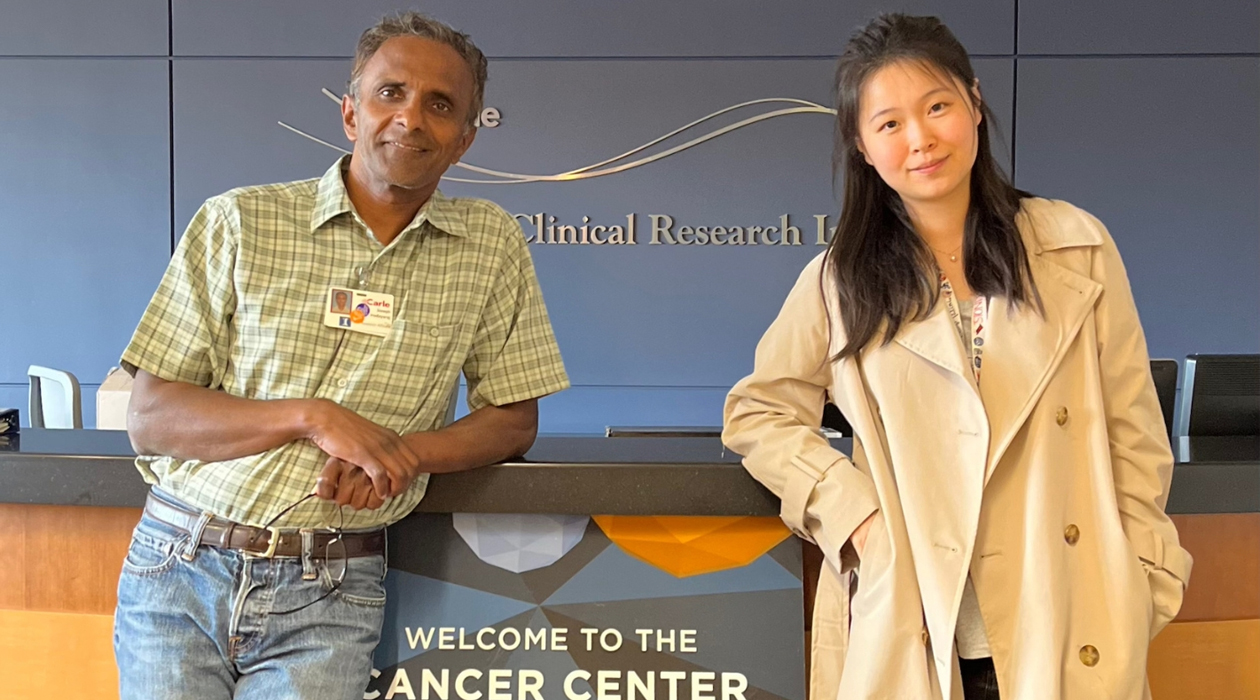Wound healing technology may help patients heal more quickly after cancer surgery

Joseph Irudayaraj (left) and graduate student Xiaoxue Han pictured here in the Cancer Center at Illinois labs located at Carle Health / CCIL Communications
Joseph Irudayaraj (CGD/EIRH), a professor of bioengineering, published new research in Nature Communications, demonstrating the potential of a new therapeutic to accelerate and enhance post-surgical wound healing. The novel technology may have import for patients with cancer, the paper states.
Approximately 6.5 million patients in the U.S. face poor wound healing outcomes. In clinical wound management, many patients experience post-surgical angiogenesis, inflammation, and hypoxia. Angiogensis is generally a growth of blood vessels from existing vasculature; though, it can cause a post-surgical condition in which new blood vessels grow inside tumors, leading to cancer expansion and metastasis, and hypoxia occurs when there is low oxygen concentration in the bloodstream, preventing homeostasis. Inflammation and hypoxia are significant drivers of anomalous wound healing, and Irudayaraj’s lab sought to remedy those problems.
For patients with cancer, surgery is often one of the first measures taken, meaning countless cancer sufferers could experience a much-improved post-surgical quality of life if Irudayaraj’s novel wound healing technology achieves successful clinical translation. The highly collaborative Illinois research team demonstrated the potential of their multifunctional hydrogel for enhanced healing, promoting angiogenesis, facilitating exosome delivery, mitigating hypoxia, and inhibiting inflammation.
“Our collaborations have been instrumental in this research,” commented Irudayaraj. “Graduate student and first author of our paper Xiaoxue Han has done an amazing job of pulling the different pieces of this project together. Randy Ewoldt’s group provided much in the area of rheological characterization. We’ve worked closely with the CCIL’s Tumor Engineering & Phenotyping facility on biological evaluation, and also with Timothy Fan (ACPP/CGD) on animal models.”
Irudayaraj’s lab constructed a wound dressing composed of a self-healing hydrogel that employs exosome-coated oxygen nanobubbles. This approach not only alleviates wound hypoxia but also offers an efficient means of delivering exosome-coated nanoparticles in hypoxic conditions. This hydrogel’s gelatin improves the wound’s hemostatic properties and mitigating the potential of hypoxia in the bloodstream. The research team found that the oxygen nanobubble releases oxygen effectively and facilitates exosome uptake in human skin cells and enhances wound closure rate.
Han observed, “Exosome therapy is very common in managing inflammatory diseases, including wound healing. Exosomes are small vehicles that can contain numerous therapeutic proteins and nucleic acids. It’s a very promising strategy for many diseases, but there are limitations. We wanted to enhance exosome delivery to bring more therapeutic agents to the cells. We also wanted to mitigate hypoxia by delivering more oxygen to the blood stream. Our hydrogel dressing is designed to also reduce inflammation at the wound site.”
When considering the implications for future clinical translation, Irudayaraj noted, “We have always thought that reviving hypoxic tissues could enhance drug delivery. This is the first time we have shown that oxygen nanobubbles could serve this purpose. We’ve now validated this concept in both cell and animal models. The next steps are even more exciting. We would like to incorporate growth factors and other chemo drugs to extend its applicability to cancer postsurgical wounds and therapy. Basic research to further understand the mechanism of action in the tissue microenvironment will be an exciting avenue for this research as well.”
---
The paper, “Exosome-coated oxygen nanobubble-laden hydrogel augments intracellular delivery of exosomes for enhanced wound healing” is available online.
Joseph Irudayaraj is a Founder Professor of Bioengineering, Associate Director for Shared Resources at the Cancer Center at Illinois, and an affiliate of the Carle Illinois College of Medicine and the Beckman Institute for Advanced Science and Technology. He can be reached at jirudaya@illinois.edu.
